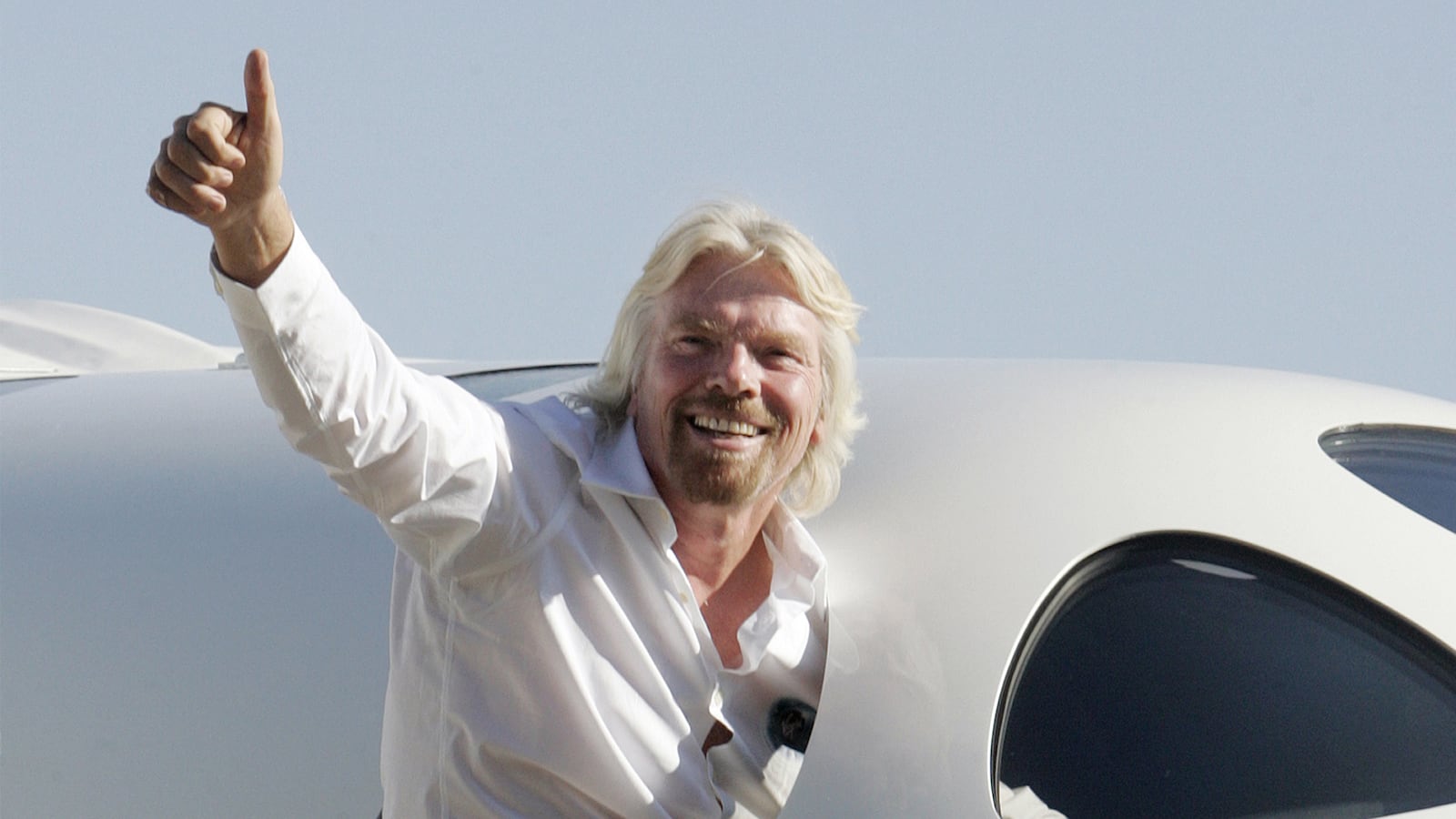The Federal Aviation Administration’s oversight of Richard Branson’s “space tourism” program was so lax that it granted Virgin Galactic waivers from safety regulations that Galactic never asked for.
That was one of the explosive findings announced by the National Transportation Safety Board on Tuesday, nine months after the fatal crash of SpaceShipTwo. Although the NTSB confirms that copilot Mike Alsbury accidently caused the crash, the Board said FAA managers prevented inspectors from interrogating Galactic’s engineers due to unidentified “political pressure.” The NTSB further alleges the FAA allowed Galactic to make test flights even though the SS2’s design did not meet all required safety standards.
Turning to the crash itself, NTSB investigators found that the test pilots were given a very high workload during the critical first seconds after SpaceShipTwo fell free of its mother ship and fired up its rocket motor.
This workload contributed to a situation where a pilot could become what the NTSB identified as a “single point failure”—in this case not a failure of a system or structure but what is defined as a “human factors failure.”
The braking device that was prematurely deployed by Alsbury is unique to SS2 and works by “feathering”—tilting the wing tips sharply upward to create an effect similar to the feathers on a badminton shuttlecock—to slow the vehicle for re-entry and landing.
The device should have been activated as SS2 reached a speed of 1,000 mph, about 26 seconds after the rocket ascent begins. Asbury activated it just 13 seconds into the flight, 10 miles above Mojave Desert. At that speed and altitude, aerodynamic forces tore the craft apart.
Alsbury was killed instantly but pilot Peter Siebold made one of the most remarkable escapes in the history of test flights. The Daily Beast has been able to reconstruct the details exclusively from an account by an eyewitness.
When SS2 broke up Siebold was thrown clear, still buckled in his seat, as though in a designed ejection. As he fell, pieces of the SS2, some large, many small, glinted in the clear sky around him along with vapor from the rocket motor that was still burning out. The debris field in the desert would be five miles long.
Flight controllers watching, horrified, in the Galactic control room at their Mojave base had lost all contact. Although telemetry provided a record of all the SS2’s systems and a cockpit video recorded the pilots’ actions, the violent breakup severed all connections with the ground. Also, because the disaster happened at such great altitude, all that was visible to observers in the desert was the dying vapor from the rocket motor.
Still invisible to everyone, Siebold, strapped in his seat, was dropping like a brick through the thin air with very little oxygen. Unless he could escape the seat, Siebold’s parachute could not be deployed. Somehow at some point he managed to release the harness. The parachute opened automatically at 14,000 feet, triggered by a barometric sensor.
It was still not clear whether Siebold was alive until, although seriously injured, he waved an arm as he neared the ground.
Since the crash, Galactic has changed the locking mechanism that controls the deployment of the feathering device—something that the NTSB has now recommended. The change is designed to prevent the system being unlocked until SS2 has reached the target speed, where the aerodynamic pressures are far lower.
In addition to highlighting a high workload on the pilots the investigators pointed out that both pilots had had very little experience of using the braking device—only seven times in non-powered test flights and twice in powered flights. “You must be on your game to get it right every time,” said one investigator.
Moreover, when they prepared for test flights in the simulator the simulator was incapable of replicating the real physical stresses in the cockpit—the extreme dynamic forces of acceleration as well as vibration and the roar of the rocket motor.
The pilots also had none of the escape mechanisms normally available to pilots risking their lives at the edge of space. They had no ejection seats, no pressure suits, and no escape capsule.
***
Spaceflight is not tightly regulated like commercial or general aviation. That would be impossible: The technology is pushing the limits and in constant flux. The range of ambition spans everything from would-be Mars missions to ferrying a single passenger with a pilot on a sub-orbital ride up to 68 miles above the Earth and down again.
Consequently, there is no enforceable safety regime, even though the FAA was assigned by Congress the responsibility for “overseeing, monitoring, licensing and regulating the public safety of the U.S. commercial space transportation industry.”
However, according to the FAA’s response to a request from The Daily Beast, the basic premise is that “spaceflight is inherently risky” and “the current law requires that commercial spaceflight crew and participants engage in these activities through ‘informed consent.’” Before a flight, crew and participants must provide their written consent to participate.
The FAA referred me to a paper titled “Recommended Practices for Human Space Flight.” This covers the whole gamut from journeys to the International Space Station to the expensive joy rides offered by the promoters of space tourism.
The recommendations are explicit when it comes to escape mechanisms.
“The system should provide the capability to abort, escape or both, during pre-flight and ascent—escape includes safely returning the occupants to Earth in a portion of the space flight system normally used for re-entry and landing.”
That might be realistic (as well as required) on the rockets and vehicles being developed by several commercial contractors to ferry astronauts to the International Space Station. To get into orbit they have to have enough power to lift sophisticated spacecraft, but in the case of relatively small and lightweight space tourism vehicles like Galactic’s there is just no way of complying with those standards, either for pilots or passengers.
Indeed, from the beginning of the development of SS2, structural weight has been a critical challenge. Given the limited amount of power available in a rocket engine integrated into a vehicle rather than that provided by a huge launch rocket that is jettisoned after liftoff, everything had to be done to pare down weight if it was going to be able to lift two pilots and six passengers to the apogee of 68 miles.
Within a design regime as tight as this, the weight of ejector seats or of an ejectable capsule with its own parachute for the pilots (or similar measures for passengers) would render the project unviable.
“Anything that adds significant mass to the vehicle would put its ability to fly in question,” a veteran NASA astronaut told The Daily Beast.
However, it is important to note that Galactic is breaking no laws nor defying any safety regulations by dispensing with any means for crew and passengers to “abort, escape or both.” “Recommended practices” are just that, recommended.
The Daily Beast asked the former NASA astronaut to review the FAA’s paper. He said, “I get a sense that they are really feeling their way in this new industry. Parts of it are a bit thin.”
So far the Galactic test flights have not been carried out using ballast to represent the full weight of flying two pilots and six passengers. Nor have the powered test flights approached anything like the apogee altitude promised to passengers—the highest the craft has so far reached is just under 13.5 miles, just one-fifth of the target.
Some days before the crash Richard Branson gave a long interview to a reporter from the Financial Times, over lunch in New York. The reporter was surprised that Branson’s manner fell well short of his reputation as a carnival barker: “Branson is an almost shy showman. He has barely made eye contact from under his sweep of silver gold hair.”
The interview ranged over the whole and varied Branson business empire, flops and successes, but it was soon clear which enterprise was his first love:
“The space company will be our flagship company. Because we’re the only private company in the world sending people into space, the next few months are obviously something that has a halo effect on every Virgin company.”
By cruel chance, that interview appeared the morning after the SS2 crash.
***
Branson was not exactly accurate when he said Virgin Galactic was the only private company sending people into space—another California-based company, XCOR, has a much more conservative, single-passenger vehicle, the Lynx, under development, offering flights at half the $200,000 Galactic price.
From the launching of the Galactic project in 2004 there has been a steadily growing gap between Branson’s irrepressible boosterism and the technical challenges involved. The original promise of flying paying passengers by 2009 was absurd. Yet Branson has persisted in announcing new dates although, inevitably, each one was missed.
Behind the scenes there was an interplay of personalities that involved a fundamental clash of disciplines and cultures. In the creation of the whole program the presiding technical genius was Burt Rutan, whose company, Scaled Composites, attracted to its Mojave base a small corps of some of the most original thinkers in the aerospace business.
The Galactic system—the mother ship with the SS2 slung under its belly—was Rutan’s concept and executing it successfully depended on his expertise in shaping and building sexy-looking vehicles in lightweight composites—plus a technology completely outside his expertise, the integrated rocket engine.
To anyone who listened, Rutan was the countervailing damper to Branson’s bling. Rutan frequently reminded people rendered starry-eyed by Galactic’s hyperbole machine (including a lot of the media) that this was a test program until proved otherwise. Sure, he believed in the ultimate aim, to make space travel publicly accessible, but he also understood better than anyone the risks involved in getting there.
But Rutan was not there for the duration. In 2007 he sold Scaled Composites to Northrup Grumman and at the end of 2010 he retired from the company. Inevitably, though, some of the new corporate bureaucratic procedures began to unsettle Rutan’s team. In 2012 Scaled Composites pulled out of the company that they jointly owned with Branson that was responsible for the production of the two Galactic vehicles, WhiteKnightTwo and SS2. Production is now solely a Branson project under the name of The Spaceship Company.
After the change a number of key people left Scaled Composites to join TSC, but the chief designer of SS2, James Tighe, remained at Scaled Composites. Rutan called Tighe “one of the smartest aerodynamicists I have ever known.” As the flight test program became more worrisome the Galactic engineers continued to rely on Tighe for guidance. And then a few months before the disaster, Tighe quit Scaled Composites to join a Silicon Valley aviation start-up. People with knowledge of the project say that Tighe is sorely missed.
Branson, meanwhile, consistently gave the impression that what was essentially a test program that needed to take careful and incremental steps toward proof of concept could segue overnight into a safe and reliable commercial operation working with the frequency of an airline schedule. No space vehicle, no matter how mature and sophisticated, has ever achieved that kind of frequency.
The pressure from the drumbeat of Branson’s hype and the FAA’s willingness to turn a blind eye to safety lapses as it repeatedly granted permission to continue the test program is what provoked the intervention in Tuesday’s public hearing by Robert L. Sumwalt , who has for some time been a zealous advocate for safety in aviation, has been a pilot himself for 32 years and is an expert on the role human factors in accidents.
Sumwalt’s attempt to find the source of the political pressure that investigators said was behind the offered waivers was thwarted, but he put his finger on what the bureaucratic problem was at the FAA—they had practiced a very narrow interpretation of their role to ensure “public safety”—their view was that they were protecting the public from any risk of collateral damage from a crashing space vehicle—not actually trying to apply strict standards to the design of space vehicles that would prevent crashes.
The FAA’s inspectors, some of them with backgrounds in NASA and knowing exactly what weaknesses to look for both in structures and the training of test pilots, were never assigned to live with Galactic program, as do FAA inspectors during the development of a new commercial airplane. They were assigned only to specific test flights.
And when they raised acute technical questions, the FAA managers intercepted them and made sure they were never conveyed to Galactic. This went on during successive renewals of the 120-day licenses to make experimental flights.
***
When the test flights are taking place the project consumes money as fast as the rocket consumes fuel—literally. Although the exact costs have not been disclosed I am told that every rocket burn costs at least $400,000 and the program is spending as much as $15 million a month.
The continual failures to meet the deadlines set by Branson have had serious economic impact in New Mexico where, near the small city of Truth And Consequences, local funds were used to build Spaceport America, to the tune of $212 million, with the idea that regular commercial flights by Galactic from there would generate a much-needed boost for the area. Last year the authority in charge reported a $1.7 million budget deficit as a direct result of Galactic’s non-appearance.
There has never been any doubt about who the Number One Passenger is going to be: Branson himself. Soon after last year’s crash he was repeating an ambition aired many times before—that he looked forward to going up—and taking his son Sam and daughter Holly with him. The idea was that seats for the Bransons would be installed in the cabin behind the pilots as soon as SS2 had achieved the apogee height in tests. (That probably couldn’t happen without the FAA approving an operator’s license, whether Branson realizes this or not.)
Whether you are an astronaut taking a ride to the International Space Station or hoping to take a sub-orbital joyride to experience a few minutes of weightlessness the journey always begins sitting on top of a rocket. Rocket motors are the only kind of power that can deliver the enormous burst of thrust needed to accelerate free of gravity.
Rocket motors are, basically, a form of controlled explosion. That is why if there is any kind of fault during a launch—as, for example, with three recent orbital rocket launches not involving passengers—the whole vehicle explodes. To get into orbit requires an escape velocity of 17,500 mph.
The demands made of the engines of SS2 are not as great, but as the NTSB investigation shows they have still pushed development to the limits. A ground test in 2007 killed three engineers and injured three others.
The death of test pilot Alsbury means that the Galactic program has now cost four lives (one more than for NASA’s entire Apollo program). This should serve as a sobering antidote to the barrage of hype that has too often mischaracterized the Galactic enterprise as a low-risk adventure for anyone who fancies it.






